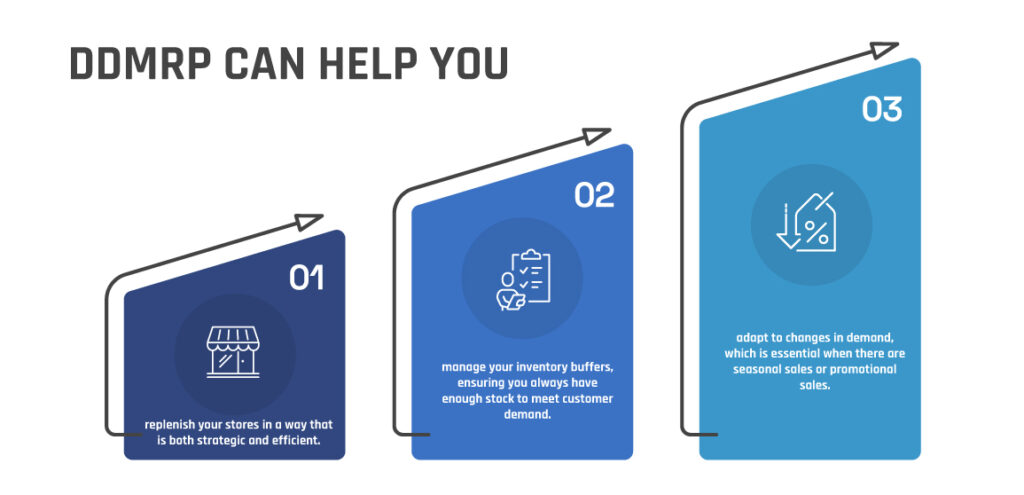
DDMRP in the Supply Chain Fashion Industry: Louis Vuitton Case Study
August 12, 2022
DDMRP in Sustainable Fashion Supply Chain
August 26, 2022When you’re planning your seasonal sales and promotional events, it’s essential to have a solid stock management plan in place. That’s where DDMRP can help.
With DDMRP, you can manage your inventory so that you always have the products your customers want when they want them. You can also use DDMRP to adapt your stock plan for promotional sales and seasonal changes.
In this article, we’ll show you how to use DDMRP when there are promotional sales or seasonal sales in your retail business.
What Is DDMRP?
So, what is DDMRP? DDMRP is a methodology that helps you optimize your inventory levels by considering all the factors that can impact the stock.
It considers customer demand, supplier lead times, and stock on hand, among other things. This way, you can make more informed decisions about what to order and when to order it.
One of the benefits of using DDMRP is that it can help you better adapt to promotional sales and seasonal sales. For example, if your store is running a sale, DDMRP can help you ensure you have enough stock to meet customer demand.
How does DDMRP manage Retail?
DDMRP can manage retail by focussing on different areas according to consumer behaviors. The five areas are:
- On the demand side
Demand management is handling demand and assuring that the firm stays client or consumer-oriented. It also covers demand-inducing processes like category administration, shopper or customer journey management, and omnichannel commerce.
- On the supply side
DDMRP delivers efficient and effective supply chain management techniques for monitoring and controlling the movement of commodities. The different standards and practices can also be combined to improve the supply chain.
- Technologies that enable
Enabling technologies encourage the continuous application of process-enabling technology. They prioritize economizing of scale and safe investment.
- Integrators
Integrators solve distinct problems in company operations. On-shelf availability, out-of-stock, shelf-ready packaging, waste precluding, shrink deduction, and collaborative planning, forecasting, and replenishment are some examples (CPFR).
- Data administration
Almost every procedure is now propagated, and every product is illustrated digitally. This generates massive volumes of data. Data management, whether it is master data, movement data, or analytical data, is vital to success.
What Are the Benefits of DDMRP for Retail?
When retailers have promotional sales or seasonal sales, it’s essential to have a replenishment strategy in place that takes into account the new stock. That’s where DDMRP comes in.
DDMRP can help you replenish your stores in a way that is both strategic and efficient. It gives you visibility into the stock across all your stores, making better decisions about what to order and when.
Also, DDMRP helps you manage your inventory buffers, ensuring you always have enough stock to meet customer demand. And last but not least, DDMRP helps you adapt to changes in demand, which is essential when there are seasonal sales or promotional sales.

How Does DDMRP Impact Replenishment Frequency?
How often should you replenish your store?
It’s a question that every retailer has to answer, and there’s no one-size-fits-all answer. But DDMRP can help you make the right decision for your business.
DDMRP considers how much stock is already in the pipeline and how that stock is spread out among your stores. This way, you can be sure that you’re not overstocking any store and adjust your replenishment frequency based on sales trends.
For example, suppose you notice that a particular item is selling faster than usual at one store. In that case, you may want to replenish that store more often than others. And if a product is seeing fewer sales, you can adjust your replenishment schedule accordingly.

How Does DDMRP Impact Visual Merchandising?
When you’re planning your stock for the season, you need to take into account the promotional sales that are going to be happening. You want to have enough supply to meet the demand of your customers, but you also don’t want to over-buy and end up with a lot of excess stock.
That’s where DDMRP comes in. When using DDMRP, you can adapt your replenishment frequency to consider promotional sales. This way, you’re not overselling, and you’re not underselling. You’re constantly replenishing your stores at just the right frequency.
But that’s not all DDMRP can do. It can also help you with visual merchandising. If you have a sale on, you can adjust your stock levels to create a visual impact that will draw in customers. And since DDMRP considers an item’s cumulative red/yellow/green zones across stores, you can be sure that your stock levels are always correct.
How Effective Are Buffers in DDMRP for Retail?
When dealing with promotional and seasonal sales, it’s more important than ever to have accurate buffers in place. The buffers are effective in DDMRP for Retail regarding stock management. In the context of promotional sales and seasonal sales, stores need to have enough stock to meet the demand from customers. Still, they don’t want too much inventory that will go to waste if the item does not sell.
The buffers help to manage this by ensuring that the stock levels are within acceptable limits. So how do you find the right balance? It’s all about experimentation and adaptation. Start by testing different buffer sizes and seeing what works best for your business. And don’t be afraid to make changes as needed. The goal is to have an effective and efficient replenishment system. This helps to prevent stockouts and overages, which can be costly for retailers. In addition, the buffers help to ensure that the stock is correctly allocated across stores. This gives teams visibility into how each store performs and allows them to make decisions based on accurate data.
Are There Any Challenges With DDMRP for Retail?
There are a few challenges you’ll need to keep in mind when adapting DDMRP for retail products on sale.
For starters, the replenishment frequency will need to be adapted to account for the promotional sales. You’ll also need to consider the impact of visual merchandising on stock levels and how buffers will need to be set up to ensure that stock is managed effectively.
Overall, the adaptation of DDMRP for retail products on sale is a great way to optimize stock levels and keep your stores well-stocked during promotional sales periods.

Conclusion
When products go on sale, it can be challenging to manage the stock and inventory to ensure that the shelves are always stocked with the newest arrivals and that there is enough stock available to meet customer demand.
DDMRP can help retailers to manage their stock and inventory more effectively during promotional sales periods. The replenishment frequency can be adapted to ensure that new arrivals are always available. The stock can be managed in relation to an item’s cumulative red/yellow/green zones across stores.
This can help ensure that the shelves are always stocked with the latest arrivals and that enough stock is available to meet customer demand.
Interested in knowing how Patrick Rigoni can step up the game of your supply chain? Contact us today and get a free consultation. Patrick Rigoni also offers in-depth DDMRP courses; if you are interested to know more about DDMRP for the supply chain for your company, here is the link to the NEW DDMRP Page.




